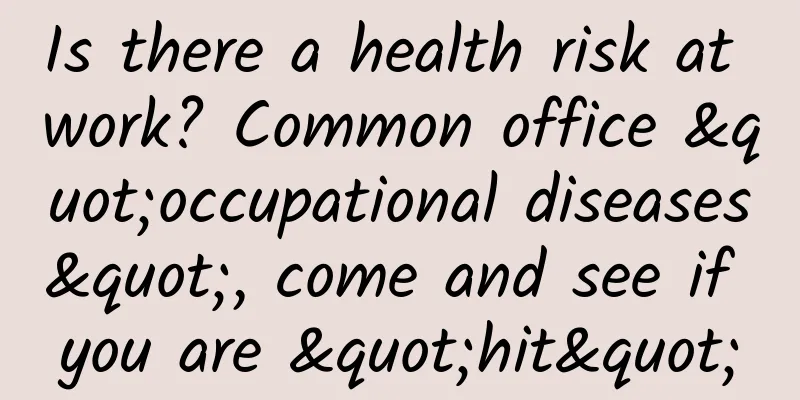Is there a health risk at work? Common office "occupational diseases", come and see if you are "hit"

|
In modern society, offices have become the core place for many people to work and live. Although there are comfortable air conditioning, bright lights and convenient office equipment here, working in such an environment for a long time will also bring a series of health problems, which we call "office occupational diseases". Today, the editor will take you to explore these common occupational diseases and share some vivid, interesting, practical and effective prevention and intervention measures. 1. Cervical spondylosis: How is your neck? When it comes to office occupational diseases, cervical spondylosis is definitely a "heavyweight" player. Looking down at computers and mobile phones for a long time and incorrect sitting posture are the culprits of cervical spondylosis. Imagine that your cervical spine is like a sapling that has been bent for a long time. Over time, it loses its upright posture. Precautions: Sit properly: Imagine yourself sitting in a magic chair that automatically adjusts to your most comfortable position. Keep your back straight, your feet flat on the ground, and your eyes at a proper distance from the screen. Take regular breaks: Every hour, just like giving your brain a short break, stand up and walk around, do the "M" exercise, and stretch your neck in all directions. Use auxiliary tools: Invest in an adjustable height computer stand and ergonomic chair, which will provide just the right support for your cervical spine like a caring friend. Interventions: If you feel discomfort in your neck, you can try hot or cold compresses to promote blood circulation and relieve pain. If the symptoms persist, remember to see a doctor in time to prevent the condition from getting worse. 2. Eye fatigue: How is your “window to the soul”? Eyes are the windows to the soul, but in the office, this window is often overloaded. Staring at the computer screen for a long time can easily cause dry eyes, fatigue, and even vision loss. Precautions: Adjust screen brightness: The screen brightness should be coordinated with the surrounding environment, avoiding being too bright or too dark to reduce stimulation to the eyes. Regularly look into the distance: Every 20 minutes, look up and out the window to relax your eyes, just like giving your eyes a deep breath. Do eye exercises: close your eyes, gently rotate your eyeballs, or gently massage the acupoints around the eyes with both hands. These can effectively relieve eye fatigue. Interventions: If the eyes are dry and severe, you can use artificial tears to moisturize your eyes. At the same time, eating more foods rich in vitamin A and lutein, such as carrots, spinach, etc., is also good for the eyes. 3. Lumbar spondylosis: Can your “old waist” still hold on? Sitting for a long time will keep your waist muscles tense for a long time, and over time, lumbar spondylosis will come to you. It makes you feel unbearable pain when you bend or turn around. Precautions: Choose a suitable chair: A chair with lumbar support can provide strong support for your waist and reduce the burden on the lumbar spine. Regular activity: Stand up and walk around every once in a while, do some waist stretching exercises to relax your waist muscles. Avoid bending over for long periods of time: When picking up objects, try to keep your waist upright and avoid bending over excessively. Interventions: If the waist pain is severe, you can use hot or cold compresses to relieve the pain. At the same time, physical therapy or massage under the guidance of a doctor can also effectively relieve the symptoms of lumbar spondylosis. 4. Psychological pressure: How is your heart? High-intensity work pressure and fast-paced life make many office workers face huge psychological pressure. If this continues for a long time, it will not only affect work efficiency, but also cause damage to physical and mental health. Precautions: Arrange work reasonably: make a reasonable work plan to avoid overwork and long overtime. Learn to relax: use your spare time to do yoga, meditation, reading and other activities to relax your body and mind. Active communication: Maintain good communication with colleagues, friends or family, share your feelings and pressure, and get their support and help. Interventions: If you are under too much psychological pressure and cannot adjust yourself, you can seek help from a professional psychologist. They will provide a personalized psychological intervention plan based on your situation. Although office occupational diseases may seem insignificant, they can have a serious impact on our physical and mental health if accumulated over a long period of time. Therefore, we must start from daily life and develop good working habits and lifestyles to prevent the occurrence of occupational diseases. At the same time, we must also learn to pay attention to our physical and mental health and take timely intervention measures to keep ourselves in the best condition both at work and in life. I hope this article can bring you some help and inspiration. Remember, only with a healthy body and mind can we better enjoy the fun brought by work and life. |
<<: Summer seasonal fruit illustration: Which one do you pick?
>>: Why can a small grating card allow people to experience a rich three-dimensional world?
Recommend
Moji Weather is about to go public. How far can Moji, which makes 99% of its profits from advertising, go?
The business model of tool products has always be...
They say: A girl weighing 90 catties is fat, and a boy who is 1.78 meters tall is short
appendix: 1. A little-known fact about body shape...
What makes Apple users so loyal? What can Chinese smartphones learn from?
In the field of smart phones, iPhone user loyalty...
Activity fission growth strategy!
In the era of mobile Internet, the topic that mar...
Which is more harmful: eating midnight snacks or staying up late and being hungry?
This article was reviewed by Pa Li Ze, chief phys...
Ideas for building a second type of e-commerce account
After many policy changes, is it still easy to do...
337 billion US dollars! Report says that by 2025, 5G mobile phones will account for more than 50% of smartphone sales revenue
A new study from Juniper Research found that 5G-c...
18 time management lessons that high-performance people must learn from a trainer from a Fortune 500 company with an annual income of one million
Wasn’t there the Luo Zhixiang’s multi-person Qigo...
How much does it cost to customize the Yongxin Musical Instruments Mini Program?
How much does it cost to customize the Yongxin Mu...
6000 words of essence, methodology to improve homepage conversion rate
In the second half of the Internet, when the traf...
How to complete a high-quality event promotion?
I was having dinner and chatting with a friend a ...
What kinds of data are mainly analyzed for SEM optimization? How do novice SEM users perform data analysis?
SEM is the abbreviation of Search Engine Marketin...
On Chance and Skill in Game Design
[[130336]] For games that require players to make...
Download the Ultimate Intelligence of the Spiritual Merchant on Baidu Cloud
The Ultimate Intelligence of the Spiritual Mercha...
"Superkids Season 1" Baidu Cloud Download Link Address
Welcome to Aixue Knowledge Network, where you can...









